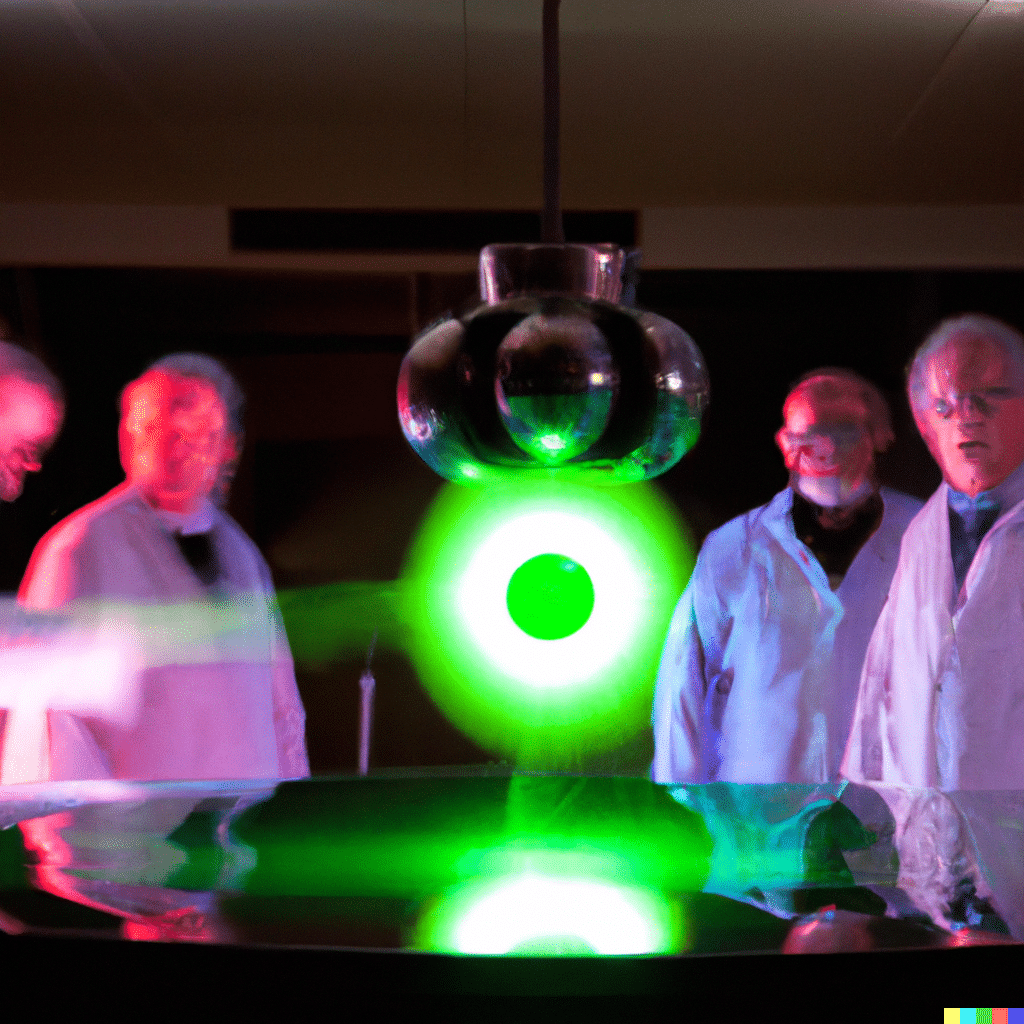It’s not even close.
The biggest story of the year happened earlier this week when the news was announced that nuclear fusion was achieved in a laboratory with more energy coming out than going in.

Note: Image generated by OpenAI…more on that laterA quick primer on nuclear fusion:
Nuclear fusion is a process in which atomic nuclei combine to form a heavier nucleus, releasing a large amount of energy in the process.
This process is what powers the sun and other stars, and scientists have been trying to harness it as a source of clean and virtually limitless energy here on Earth.
This process is what powers the sun and other stars, and scientists have been trying to harness it as a source of clean and virtually limitless energy here on Earth.
In a fusion reaction, two atomic nuclei come together to form a heavier nucleus and a subatomic particle called a neutron. This reaction releases a tremendous amount of energy, much more than is released in a typical chemical reaction, such as burning fossil fuels.
Nuclear fusion is the opposite of nuclear fission, where in fission atoms are split but in fusion, they are joined together.
That means, unlike fission, there is no pollution. Meaning there is no risk of Chernobyl or Three Mile Island power plants going boom.
Also, in theory, the fuel supply is limitless (we are stuck using deuterium right now but other elements can be used in the future as technology permits).
In comparison, atomic energy currently provides a relatively small but significant percentage of the world’s energy needs, despite the fact that nobody in North America and Europe wants to build new plants and actively trying to shut down existing ones.
According to data from the International Atomic Energy Agency (IAEA), nuclear power currently accounts for about 10% of the world’s electricity generation, and about 4% of the world’s total energy consumption.
So when do we get cheap and limitless power? I give it about twenty years. (see editor’s note for a different opinion).
The first nuclear fission in a laboratory was achieved in December 1938 by a team of scientists led by Enrico Fermi, who was awarded the Nobel Prize in Physics for this achievement in 1939. The first commercial nuclear power plant, the Shippingport Atomic Power Station, was built in the United States and began operating in December 1957, almost 19 years later.
That takes us to 2043 when I will be in my seventies. In another 20-30 years, I think, and fusion will be the dominant form of power generation on the planet.
And that will lead to another transformation of human society, much like the substitution of coal power for human muscle led to the industrial revolution.
Let Us Welcome our New Artificial Intelligence Overlords
That means, unlike fission, there is no pollution. Meaning there is no risk of Chernobyl or Three Mile Island power plants going boom.
Also, in theory, the fuel supply is limitless (we are stuck using deuterium right now but other elements can be used in the future as technology permits).
In comparison, atomic energy currently provides a relatively small but significant percentage of the world’s energy needs, despite the fact that nobody in North America and Europe wants to build new plants and actively trying to shut down existing ones.
According to data from the International Atomic Energy Agency (IAEA), nuclear power currently accounts for about 10% of the world’s electricity generation, and about 4% of the world’s total energy consumption.
So when do we get cheap and limitless power? I give it about twenty years. (see editor’s note for a different opinion).
The first nuclear fission in a laboratory was achieved in December 1938 by a team of scientists led by Enrico Fermi, who was awarded the Nobel Prize in Physics for this achievement in 1939. The first commercial nuclear power plant, the Shippingport Atomic Power Station, was built in the United States and began operating in December 1957, almost 19 years later.
That takes us to 2043 when I will be in my seventies. In another 20-30 years, I think, and fusion will be the dominant form of power generation on the planet.
And that will lead to another transformation of human society, much like the substitution of coal power for human muscle led to the industrial revolution.
Let Us Welcome our New Artificial Intelligence Overlords

The second biggest story of the year is the release of ChatGPT, the latest tool released from the OpenAI project.
Since ChatGPT has been released, my Twitter feed has been flooded with tweets about ways the tool can be used to write almost…anything.
Here is one thread on how it can generate a SEO strategy for your website: https://twitter.com/heykahn/
Here is another thread on how it can function as your personal assistant:
https://twitter.com/
At the very least, ChatGPT will revolutionize how universities teach and grade their students. Nobody will be writing an English or History essay without ChatGDP.
But one group that is most excited about ChatGPT are the … software developers.
Apparently, ChatGPT is superb at writing code. So it will revolutionize that industry as well.
Also, the OpenAI team say they will release a better version of ChatGPT in 2023.
Artificial Intelligence has now evolved to the point where it will transform the workplace over the next decade.
End of an Empire: The War in Ukraine

The Russian Empire was founded in 1721 by Peter the Great, who became the first emperor of Russia. Prior to this, the lands that now make up Russia were a collection of independent states and territories that were ruled by various princes and nobles.
Peter the Great implemented a series of sweeping reforms, including the creation of a strong central government, the establishment of a regular army, and the modernization of the country’s economy and infrastructure.
Peter’s reforms helped to establish the Russian Empire as a major European power, and his successors continued to expand the empire’s territory and influence.
Over the next several centuries, the Russian Empire grew to become one of the largest and most powerful empires in the world, encompassing much of Eastern Europe, northern Asia, and parts of North America.
Over the next several centuries, the Russian Empire grew to become one of the largest and most powerful empires in the world, encompassing much of Eastern Europe, northern Asia, and parts of North America.
That’s four hundred years. During that time period, Russia won wars with France (in the time of Napoleon) and Germany (Hitler) but lost the Cold War with the United States.
And now it’s breaking up. Holding onto Ukraine was essential to the survival of Russia as an empire. But now it’s bleeding out, literally.
Even if Russia pulls a rabbit (or, how about a black bear?) out of a hat and “wins” in Ukraine, it will be exhausted, much like Britain after the Second World War.
Here is a damning fact for you. The population of Russia in 1939 was 170 million. The United States had 150 million people, and China had 268 million.
In 2023, China has 1.4 billion people. The US has 331 million. Russia has 145 million people, fewer than it had in 1939.
Demography is destiny.
The Nothingburger that is Crypto
You may think it’s strange that I am so dismissive of crypto while writing story after story every week on the subject.
I am only interested in crypto because it pays the bills: the mortgage, my kid’s university tuition, and the cases of wines that appear on my doorstep from the vineyards in Okanagan Valley.
But as far as crypto changing the world? We are still waiting on that. The numbers don’t lie.
Remember that the total market cap of all crypto is less than $900 billion. That sounds like a lot, but if it was an American public company it wouldn’t even rank in the top five.
Crypto just doesn’t rank that high in the realm of financial flimflammery. Sam Bankman-Fried ripped off depositors and investors to the tune of $10 billion. That’s nothing.
In 2008, Bernie Madoff confessed to a fraud that exceeded $50 billion.
Crypto is small potatoes and so far, inconsequential to most of society. But it is sometimes amusing.
Conclusion
“The future is already here. It’s just not evenly distributed yet” — this quote is often attributed to science-fiction author William Gibson, though no one seems to be able to pin down when or if he actually said it.
Clean, almost free, almost-limitless power is not yet here. But we can see the future of it from this point in time.
Artificial Intelligence smart to do most white-collar jobs or at least make every white-collar worker more productive by an order of magnitude, is here already.
Nearly one million users have already signed up to OpenAI dashboard to play with ChatGPT.
In the past lies the Russian empire, which played an outsize role in European and Asian history since before America became a country.
So many people are forecasting the 21st century to be one of bleakness and ongoing disaster. But the top three new stories of 2022 suggest otherwise.
To have hope one must have imagination, and the doomsayers of today have neither.
DJ
Editor’s Note #1: I’m already seeing pushback about the fusion breakthrough.
This article specifically notes that the energy needed to create fusion was 100x greater than the energy released, and therefore the experiment was a dude. But the writer is confusing physics with logistics.
The energy that shined on the pellets via laser released 20% more energy (input < output) but the energy needed to produce the laser output was 100x greater than the energy of laser beams that were shined on the pellets.
However, that was a laboratory setup.
All we need now is to improve efficiency by an order of 100 to 1000. This sounds like a tall order except that has been easily done before in the history of technology.
For example, semiconductor production and telecommunication have seen orders of magnitude much greater than 100x over the last forty years.
Heck, the first flight by the Wright brothers was estimated to have a top speed of 48 km/hour. Fifty years later, the speed of the SR-71 Blackbird was 3540 km/hour.
Have a little patience, people.
Editor’s Note #2: If you haven’t guessed already, significant parts of this article were written with the help of ChatGPT. Also, all the images were generated by OpenAI image generator.
